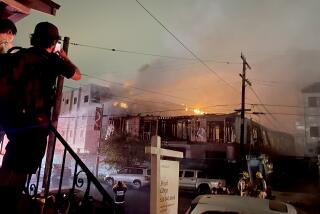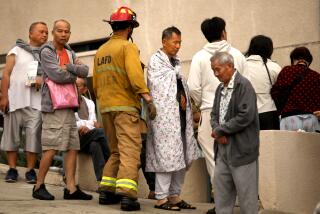Official Had OKd Site of Blaze
A fire inspector in May found no violations at a dilapidated South Los Angeles warehouse -- the same building where authorities discovered dozens of people living Friday when a fire broke out, killing one resident.
Fire officials said Tuesday they didn’t know how long people had been living on the second floor of the building. But several neighbors who work around the warehouse near Slauson and Normandie avenues said they thought the structure had been used as makeshift apartments for as long as two years.
“We saw a lot of people going in and coming out all the time” through a stairway in the back, said Edgar Soto, 20, who works at a carpentry shop next door.
A co-worker, Daniel Lemus, 50, said most of the residents -- who lived in tiny rooms and shared a common kitchen -- seemed to be incapacitated. “There was a woman in a wheelchair. There was a man who used crutches. There was another woman who didn’t walk right,” he said.
Los Angeles Fire Battalion Chief Ralph Terrazas said he didn’t know whether the inspector missed the dwellings.
“The only reason he wouldn’t have gotten up there [to the second-story living space] would have been because he had no knowledge of it,” Terrazas said. “The inspector may not have found the stairwell that led to the second story. He might have walked in the front door, verified the information on the building and went on to the next inspection.”
Terrazas described the building as deceptive because the 10 illegally converted dwellings on the second floor were invisible to passersby on the street. He said the only access to the second story was through a stairwell in an alleyway.
Had the inspector found evidence of people living in the warehouse, he would have referred the matter to the Los Angeles Department of Building and Safety, which probably would have relocated the residents and issued a citation to the building owner.
Commercial buildings such as the warehouse are supposed to be inspected once a year. According to Los Angeles Fire Department records, inspectors visited the building in 2002 and 2003 but could not get inside. They did an inspection of the exterior and concluded in their reports that there were “no visible hazards.”
The annual inspections, Terrazas said, are designed to ensure that commercial buildings follow fire safety rules. Inspectors look for such violations as inadequate fire extinguishers and exits, narrow passageways and other hazards
The fire broke out early Friday morning, with residents pressing their faces against the barred windows as firefighters arrived.
The Department of Building and Safety concluded Monday that the warehouse had been illegally converted into housing units. The building was unfit for occupancy because of hazardous electrical wiring and unreinforced walls, ceilings and floors, department officials said. The building also lacked smoke detectors. Investigators believe a cigarette started the blaze.
City officials think illegal conversions are becoming more common as rents continue to rise, making it harder for poor people to find a place to live. They said they have seen people living in attics, basements, garages and industrial buildings.
The fire has prompted some members of the City Council to call for a more coordinated effort to combat the problem.
“There’s no question there are too many people living in inhumane conditions in the city,” said Councilman Eric Garcetti, who heads the council’s housing committee. “The city has to do better both in building safe and clean and decent housing, as well as making sure we have the resources to conduct regular, timely inspections.
“We also need to make sure all agencies are acting together, so when the Fire Department finds something, Building and Safety knows about it right away,” he said.
The lack of affordable housing has long been an issue in Los Angeles, where construction of new units lags far behind growth in the population. As of late 2003, there were more than 20,000 families on the city Housing Authority’s waiting list for public housing, and 70,000 more had registered for Section 8 federal housing vouchers.
Larry Gross, executive director of the Coalition for Economic Survival, a tenants rights organization, said that more inspections and code enforcement should improve the situation, but that it wouldn’t be enough to solve the problem of unsafe housing in Los Angeles.
“The reality in this city is people don’t want to live in those units, but they don’t have any choice, because it’s the only thing they can afford,” he said.
*
Times staff writers Zeke Minaya and Jessica Garrison contributed to this report.
More to Read
Sign up for Essential California
The most important California stories and recommendations in your inbox every morning.
You may occasionally receive promotional content from the Los Angeles Times.











